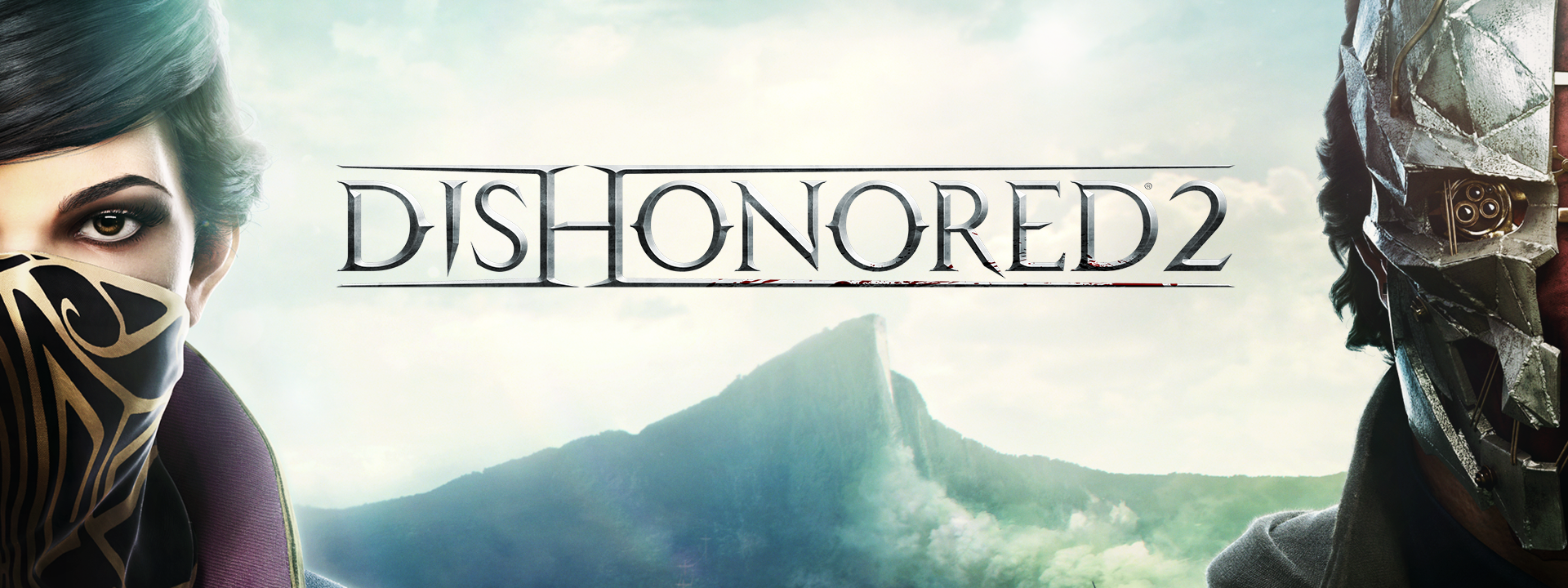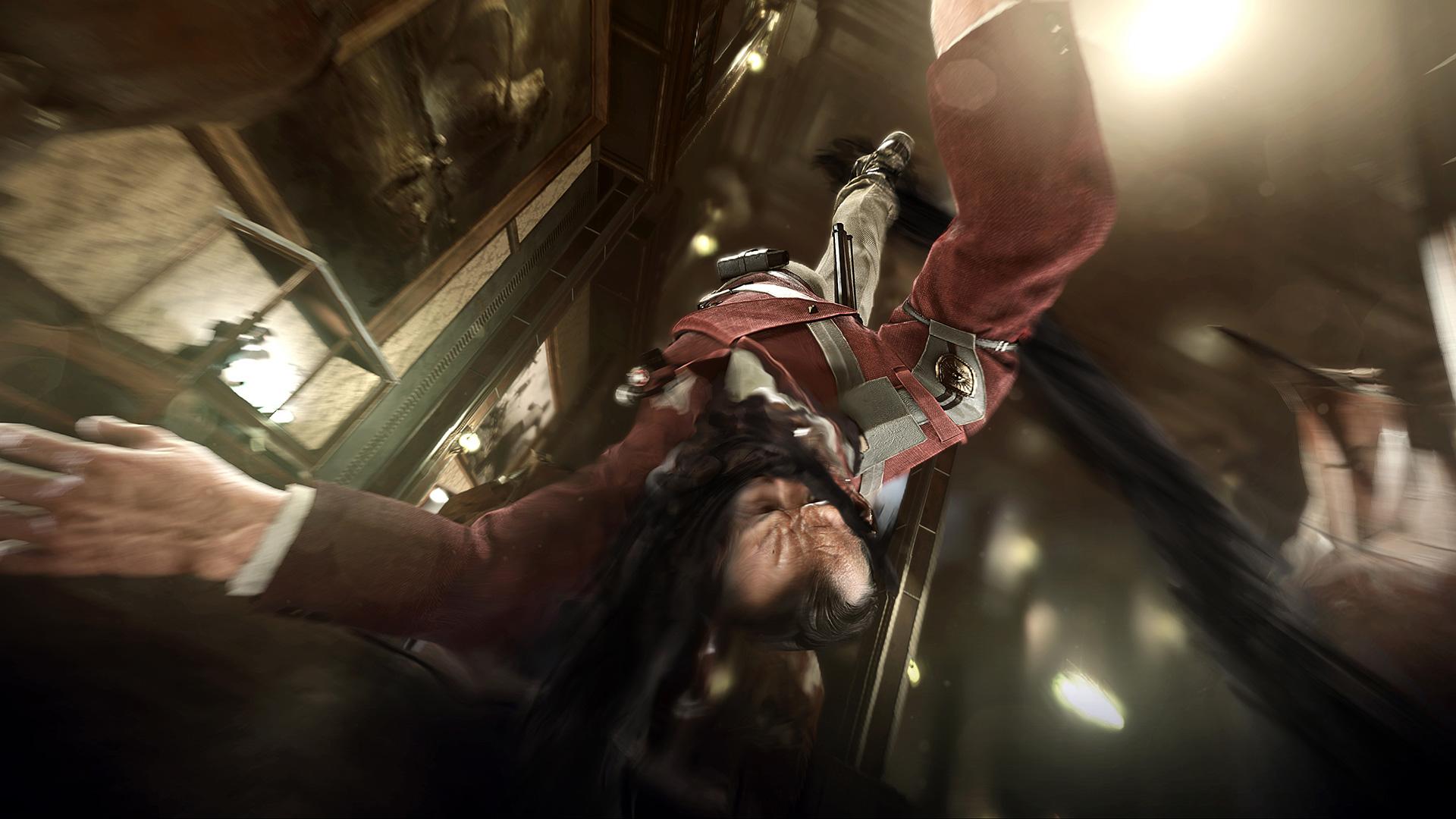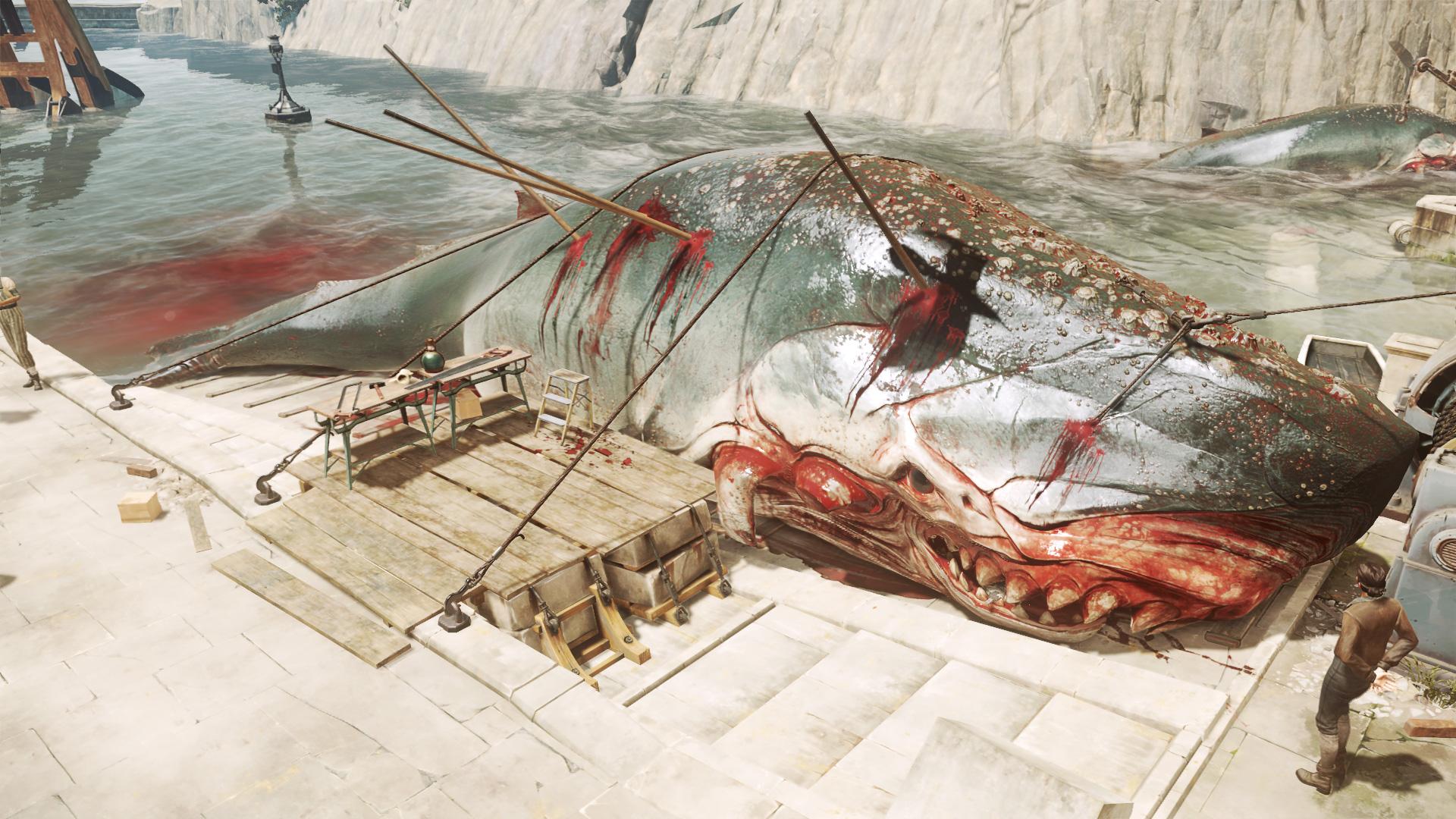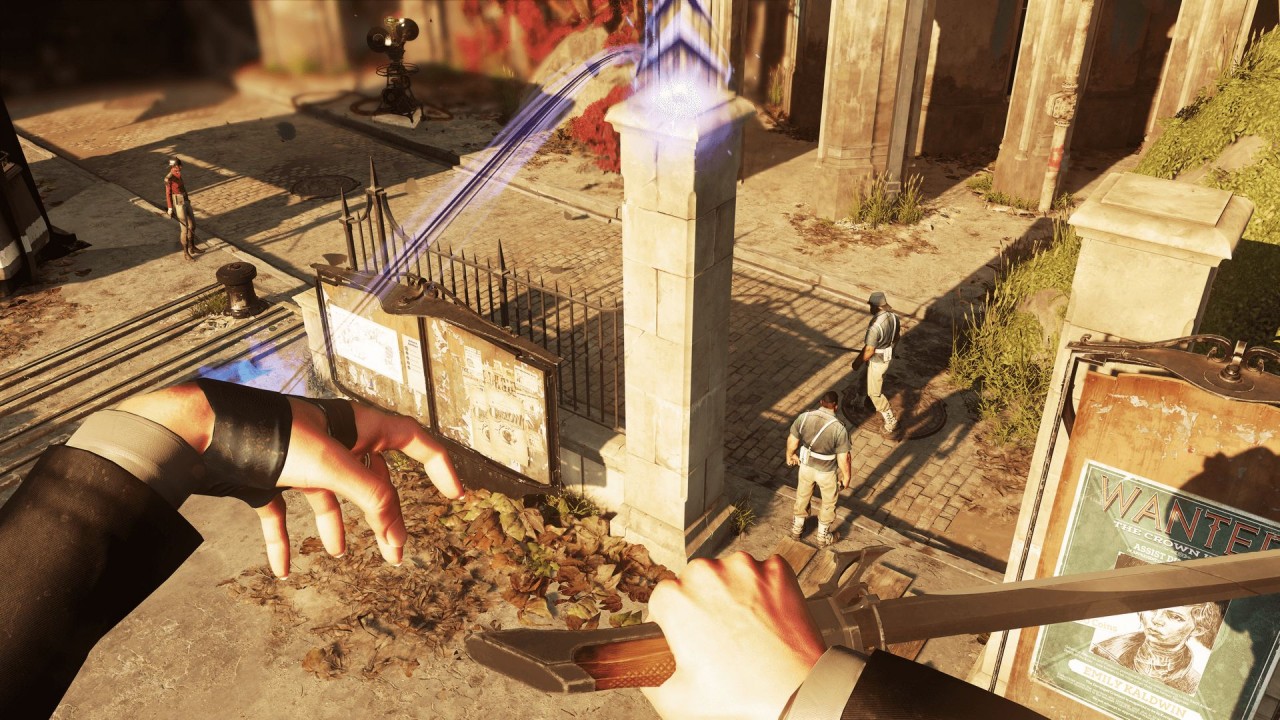
DISHONORED is one of my favorite games to come out this decade. The steampunk revenge stealther was a callback to games of old, leading the charge with DEUS EX: HUMAN REVOLUTION in resurrecting what video essayist Mark Brown dubs “The Immersive Sim.” And immersive it was, lacking any of the handholding or cinematic railroading that defines modern gaming. There were no invisible walls. You could interact with every facet of your environment, go anywhere you wanted, and even accidentally (or intentionally) kill characters that were integral to the plot. In a time where so many games want to be movies, it was inspiring to see a title give the player agency in ways that no other medium can. If being a sequel alone didn’t raise the stakes enough, the legacy that was established earlier means that DISHONORED 2 has some very big shoes to fill.
Picking up 15 years after the first game, Empress Emily Kaldwin is once again betrayed by her inner circle of advisors, blamed for crimes she didn’t commit, and dethroned in a bloody coup. This time around, however, it’s her aunt Delilah, who played a pretty big part in DISHONORED’S expansions, who wants the crown. As either Emily or her father, Corvo, the player will have to eliminate Delilah and her new regime in order to retake the throne and clear their names. If this all sounds familiar, it’s probably due to the fact that DISHONORED 2 copy and pasted the entire premise of its predecessor, down to the plague setting and the archetypal villains that run it. But as I’ll get to later, DISHONORED 2 is one of those rare titles where the plot truly deserves to be secondary to gameplay.

It’s kind of hard to tell what’s going on here, but you know it won’t end well for this guy
The most significant addition to DISHONORED 2 is the vaunted ability to choose between playing as Corvo and Emily at the onset of the game, a la RESIDENT EVIL. The narrative remains the same regardless who you choose, with only the dialogue changing between playthroughs, but each character has a separate selection of magical powers at their disposal during gameplay. Corvo retains his abilities from DISHONORED, albeit with minor alterations, while Emily boasts an all new selection of spells. DISHONORED 2’s massive, labyrinthian stages feature countless approaches to each target, and since some are only accessible by using each character’s specific skills, players are given even more of an incentive to experiment with multiple save files.
One of the few, but pernicious nonetheless, issues with DISHONORED was the divide between lethal and non-lethal approaches. Striking a name from your shit list without taking their life was an exquisite puzzle that came with the added benefit of a better ending. Enslaving an aristocrat and selling him into slavery at his own coal mine was far more poetic and rewarding than, say, lobbing a grenade at him. That being said, foregoing murder meant you were pretty much limited to chokeholds and sleep darts for the entire game, a stifling experience when you have explosive crossbows, high voltage Tesla coils, and spells that summon packs of killer rats at your disposal. It was a shame that sparing the lives of your targets was so appealing when doing the same for their guards was a chore.
DISHONORED 2, thankfully, ameliorates this frustrating dichotomy. While Corvo’s spells are just as deadly as ever, Emily’s can all be used to nonviolent ends. In addition, both characters now have access to widely expanded less-than-lethal options, including tackles, melee counters, and devices like ether bottles and hallucinogens. What this means is that players going for a no-kill run finally have the agency to participate in combat, a feature that comprises half the game and was previously locked behind a lethal-only wall. While there are still plenty of ways to (very brutally) kill your foes, pacifists finally now have a real seat at the table.

The whales are still screwed, however
The other problem with DISHONORED was it’s writing. The plot was predictable and cliched, and the dialogue was just as painful as the bored voiceovers. DISHONORED 2 is more or less the same. The VO has improved in that the player character is now fully voiced, and developer Arkane Studios finally got a clue and hired actual voice actors rather than simply throwing lines at Hollywood celebrities, but the end product is still leagues behind the competition. The plot, beyond being recycled, is just as contrived, existing solely to serve the assassination-driven gameplay Characters reveal their intentions in the same breath that they introduce themselves, making the intrigue carry all the nuance you’d get from my performance as “lead rat” in my fifth-grade class’s play.
I can’t forgive the writing, given how central of a place the narrative is given. What I can take solace in, however, is that the narrative that really matters is told through the game’s world, and the way the player interacts with it. The coastal city of Karnaca is literally buzzing with activity, and that’s not just because of the giant mosquito infestation that is ravaging it. Nearly every room, alleyway, and shallow grave has a story to tell or a quest to offer. But where a larger package like SKYRIM or FALLOUT 4 will resort to simple fetch errands or settlement defenses as a means of padding, DISHONORED 2’s detours often overshadow the missions themselves. It’s not uncommon to spend up to an hour inside an apartment building or art gallery that’s on the way to your destination, turning over every bed and lamp shade for hidden treasures, secret shrines, or squatters with offers.
The truth is that DISHONORED 2 is unrivaled within the medium in its use of world-building. While the script falters, the lore is exceptional, not just in its imagination, but more importantly, in the way that it is implemented and absorbs the player into the setting. But the immersion doesn’t stop at the strength of the background. The use of violence plays a vital role in the way Karnaca develops, and killing people changes more than your score and the weight of your conscience. More bodies means more disease-carrying vermin, which in turn leads to more infected townsfolk facing off against you. Thinning down the constabulary will correspond to higher numbers of armed thugs prowling the streets, as well as instilling their comrades with a more righteous fury should they catch you on patrol. Your allies at home and among the citizenry will view you either as a bloodcrazed butcher or a benevolent hero of the people depending on which path you choose, but the difference here is that where so many other games determine this through strict dialogue branches and “yes or no” button prompts, DISHONORED 2 achieves this entirely through the context of its stealth gameplay.

The American dream means nothing on my streets but police and trash
“Okay, it pushes the boundaries of visual storytelling, but what about gameplay?” If there is one thing I’m glad hasn’t changed, it’s DISHONORED’s eclectic and effective mix of genres: one part platformer, one part action, and two parts stealth that you don’t really get anywhere else (because since when was stealth ever essential in ASSASSIN’S CREED?). Though it’s infinitely more satisfying, in this writer’s opinion, to stick to the shadows and rooftops, DISHONORED 2 is equally as capable as a swashbuckler, sword and pistol in each hand.
Genre blending isn’t anything new, but the way Arkane manages to utilize each system in every level of gameplay is really something else. Sliding allows the player to reach inaccessible areas, but it can also be used in combat to trip enemies, setting them up for a finisher. Bodies can be dragged into closets or thrown into the ocean to cover your tracks, or they can be dropped through a skylight to terrify the occupants below. Even your sword is useful outside of a fight, as guards will leave their posts to investigate if you clang it against a wall. And again, none of these actions are initiated by intrusive prompts, but rather by the player’s own creativity and volition.

Lil Steamyachty
Environmental narration aside, DISHONORED 2’s map design offers a fantastic degree of player freedom. Targets can be reached by any means imaginable, whether that’s crawling through sewers and ventilation shafts, leaping from balcony to balcony, slugging your way through guard posts, or even ingratiating yourself with those who have exclusive access. Each map is seamlessly divided into separate social ecosystems, with friendly merchants operating their stores on streets patrolled by the hostile town watch. Thugs, violent plaguebearers, and witch covens all loiter in the shadows, and a clever player will find ways to exploit these often overlapping zones of control and pit the factions against each other. While the fourth mission’s Clockwork Mansion is guaranteed to go down in the pantheon of great video game levels (and could have an entire article dedicated solely to it), each locale is a brilliant exercise in layout.
A lot of people have, and will continue to, compare DISHONORED 2 to DEUS EX: MANKIND DIVIDED. After all, these two immersive sims came out within months of each other, just as their predecessors did four years ago, and both are helping to bring back a genre that was long thought dead. But I’d prefer to hold DISHONORED 2 up to this year’s HITMAN. Though DISHONORED 2 is the ninja to HITMAN’s chameleon, both are defined by their massive stealth sandboxes, endless replayability, and a stubborn insistence to follow irrelevant narratives, despite already nailing the trailblazing emergent gameplay that their peers fail to grasp. I can only hope that the industry learns the right lesson from DISHONORED 2, which is that treating the audience with respect and handing the reigns from the developer to the player will create games that are far more memorable than any cinematic, effects-reel blockbuster. If you want to witness the new frontier of gaming, DISHONORED 2 is an absolute essential.
Verdict: Recommend
Reviewed on PlayStation 4, also available on Xbox One, PC
